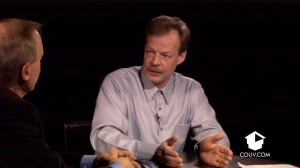World renowned transportation architect Kevin Peterson says the manual for the Washington State Department of Transportation (WSDOT) is well written and well respected around the nation, but he has difficulty understanding why it was not followed to create the design for the Columbia River Crossing Light Rail Tolling project.

In 2010 frustrated engineer friends requested that Peterson review the Columbia River Crossing (CRC) as proposed and offer feedback. What Peterson saw was enough of a concern that he contacted the CRC directly and asked to meet with project officials.
“When I looked at the project in 2010, I could not see that they had considered a collector distributor for a bridge replacement,” says Peterson. “Why the project did not consider a collector distributor is what I find disturbing.”
The collector distributor option (CD), one that is spelled out in the WSDOT manual, greatly simplifies the design by placing local traffic on the bottom level with the faster freeway traffic on the top level.
During their spring 2010 CRC meeting, Peterson presented a “notional indication of the benefits associated with a collector distributor” versus the braided design the CRC pursued. A braided design gets its name from its appearance. When viewed from above its intertwining on and off ramps appears braid-like. Peterson feels that on this project the braided design creates interchanges that are spaced too closely together and ultimately unsafe. Based on his experience, expertise and solid reputation that has been the foundational bedrock of Peterson’s career, he believed that his input would be valuable.
The CRC’s response to Peterson?
“Nothing. Nothing. Absolutely nothing.”
Peterson watched with increasing disappointment as the CRC, when questioned in public, suggested that there were problems with his idea, but the CRC only alluded to problems, and called his concept “fatally flawed,” without ever identifying anything specific. According to Peterson there are significant benefits to the collector-distributor model. It straightens the grossly amplified curve in the current CRC design. It avoids massive land-take in the downtown area and virtually eliminates encroachment on Fort Vancouver. It even goes farther and connects downtown with the fort. The biggest plus of Peterson’s concept offers superior safety and congestion relief with a projected outcome of reducing the number of potential deaths from vehicular accidents.
From all appearances, the CRC bulldozed forward with a braided design, which grossly impacts Hayden Island. Hallmarks of the design that Hayden Island can look forward to are objectionable noise, the takeover of the equivalent of 19 to 21 city blocks, or 33-46 city blocks when the broadcast of freeway noise is considered. As currently planned, the overwall CRC freeway structure swells over Vancouver in a manner that Peterson hasn’t seen since the 1960s when freeways were built without real regard or consideration for urban environments.
“It’s a brutalistic structure that is being laid over Vancouver,” says Peterson, and if the freeway has to be raised 30 feet to accommodate river shipping it makes his assessment even more dire. He compares it to a “gorilla sitting in your front yard, and you get to look at the hind end.”
Peterson now joins the frustrated engineers who pulled him into this review. He doesn’t understand the CRC mentality that is content with using a braided design that only meets minimal standards and costs substantially more.
“When I saw that this was the solution it shocked me,” says Kevin Peterson. Peterson continues to seek answers to his fundamental questions:
- Why does the CRC project office refuse to consider a collector distributor?
- What are a design flaws that the CRC office has alluded to in a collector distributor model?










